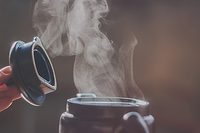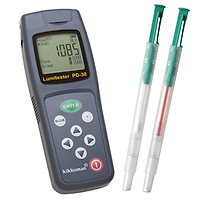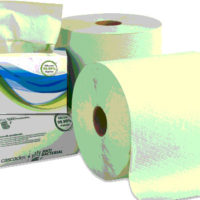Food Processing Surface Sanitation Using Chemical-Free Dry Steam

Cross-contamination of food substances with pathogenic microbes during processing poses a significant health risk for the U.S. population as well as liability for food industries. Various bacteria--e.g Staphylococcus aureus and Salmonella spp.--can survive on hands, clothes and utensils for hours or even days after initial contact with the microorganisms. Transfer rates of cross-contamination among hands, foods and kitchen surfaces were found to be highly variable (0.0005% to 100%).[1]
Salmonella enteritides, Staphylococcus aureus and Campylobacter jejuni survive on stainless steel surfaces at room temperature. The transfer rate from sponges to stainless steel surfaces was studied and it was found that those pathogens remain viable on dry stainless steel surfaces and present a contamination hazard for long periods of time, depending on the pathogen and contamination level.[2]
Listeria monocytogenes is ubiquitous, and cross-contamination is a serious public health concern. There are strains that are more heat resistant or can persist even after exposure to alkali and chlorine post-processing.[3] Some microorganisms that can adapt to acidic environments include Salmonella enterica, Eschericia coli O157:H7 and L. monocytogenes. Table 1[4,5] below describes the four common food pathogens--studied here--and includes basic information such as foods they contaminate, illnesses they cause and the annual number of cases of hospitalizations and deaths attributed to each.

Cross-contamination is best controlled with regular sanitation.[6] For example, one approach is to sanitize surfaces and equipment at the end or beginning of each day or even throughout the day, thereby limiting potential cross-contamination to a single date or lot number. However, it may not be as simple as it sounds to disinfect surfaces using traditional cleaning methods, including heat or chemicals. The chemical methods typically employ strong oxidizers, such as hypochlorites, chlorine dioxide, iodophors, peroxyacetic acid and quaternary ammonium compounds, which are most effective if allowed to react for extended periods with use of adequate concentration and appropriate temperature and are toxic for humans if ingested.[7] Microorganisms have also developed survival mechanism to tolerate various stresses during food processing, including formation of a biofilm. Bacterial resistance to sanitizers is possibly secondary to presence of a biofilm, which is often seen with Salmonella spp., Listeria spp., Campylobacter spp. and several other bacterias. Chemical sanitation methods may delay processing as well as introduce the added risk of cross contaminating foods with cleaning agents.[8]
Current trends in the food industry are towards chemical-free, organic foods.[9] One approach to chemical-free cleaning is “dry” steam cleaning. Dry steam is produced by a jet of superheated, vaporized water that immediately evaporates, leaving behind little to no wastewater production. This process dates back to the 1920s, where dry steam was used to remove grease from heavy machinery. The jet of steam is highly effective at cleaning animal fat and dried, otherwise difficult to remove substances from surfaces and equipment. In the last two decades, smaller and drier units have been made available by suppliers, including AmeriVap, Tecnovap, Goodway, Dupray, Menikini and Steamericas. Portable, dry steam units have the ability to rapidly eliminate difficult-to-remove animal and plant materials from surfaces and equipment. These units leave behind no residue and are nontoxic, fitting well into green cleaning programs. There is therefore increased demand across various industries most likely due to consumer trends towards organic and toxin-free foods.[10] In this study, one of the higher powered and notably portable dry steam cleaners (“the Optima SteamerTM” manufactured by Steamericas, Inc. in Inglewood, CA) was evaluated for the efficacy of removal of food substances and elimination of food pathogens in food substances from stainless steel.
Materials and Methods
Based on commercial and health relevance, four microbes were selected for efficacy studies (see Table 1 above for descriptions and relevance): S. aureus subsp. aureus (ATCC® 6538), L. monocytogenes (ATCC 19111), Campylobacter coli (ATCC 33559), and S. enterica subsp. enterica (ex Kauffman and Edwards) Le Minor and Popoff serovar Choleraesuis (ATCC® 10708D-5). Bacteria were purchased from ATCC (Manassas, VA) and maintained and tested for the ability to generate colony-forming units (CFUs) following procedures and using growth and test agar plates as described in the respective product sheets found on the ATCC website (Staphylococcus aureus subsp. aureus, ATCC 6538, http://www.atcc.org/Products/All/6538.aspx#documentation, Listeria monocytogenes, ATCC 19111, http://www.atcc.org/Products/All/19111.aspx#documentation, Campylobacter coli ATCC 33559, http://www.atcc.org/Products/All/33559.aspx#documentation, and Salmonella enterica subsp. enterica, ex Kauffman and Edwards, Le Minor and Popoff serovar Choleraesuis, ATCC 10708D-5, http://www.atcc.org/Products/All/10708D-5.aspx#documentation).
Five food-like substances were selected: pasteurized whole vitamin D milk, sterile organic beef broth, sterile organic chicken broth, sterile drinking water (later purchased from Vons, Anaheim, CA) and sheep blood (Sierra for Medical, Whittier, CA). The selected test surface was 4” × 4” custom stainless steel plates with holes drilled at each corner for mounting (Stainless Supply, Monroe, NC). A “target zone” of 5.1 cm2 was drawn with a waterproof marking pen (Sharpie™) using a circular template. Plates were enclosed in tin foil and autoclaved for 35 minutes at a pressure and temperature of 1.0–1.5 bars and 125 °C that resulted in sterilization, as indicated by autoclave indicator tape. Stainless steel plates were washed and reused for multiple test runs and sterile conditions were maintained throughout all procedures. At room temperature, sterile stainless steel plates were transferred to a class II biohazard hood. An aliquot of late log-phase culture was diluted in culture medium and an estimated 5,000 cells were transferred to 500 µL of matrix solution and mixed by pipette re-pipette five times. A sterile swab was immersed in the solution and used to swab the target area five times. The swab was then re-introduced into the solution and the plate was turned 90 degrees and swabbed again five times. Inoculated plates were transferred to the exposure chamber in their tinfoil wrappers.
The exposure chamber consisted of a modified glove box (Plas-Labs, Lansing, MI) with a pass-through chamber. Operators wore a biohazard suit, full-face respirator and double gloves during operations and the study was conducted in a room with HEPA filtration designed for sterile and biohazard workflow. A 0.22-µm filter (OptiScale Capsule Durapore 0.22-µm filter; Millipore, Billerica, MA) was added to the exposure chamber air input port. The output ports were fitted with tubing, which passed through a 4-L and then 2-L vacuum flasks prior to vacuum pumps. The 4-L vacuum flask was filled with a 50% bleach solution and constructed such that air coming from the chamber bubbled through the bleach solution prior to the second dry vacuum flask. One output port was a general exhaust that could be toggled to clear the pass-through chamber or the chamber itself. The second output port was fitted with a large diameter funnel, which was used to clear the line and ensure a steady flow of steam prior to exposures (described below). The chamber was fitted with a dehumidifier (Frigidaire), which operated continuously during and after exposures. Routine clean up was conducted after each exposure using 70% isopropanol. A squeegee and sponge were used for cleaning between test runs. Excess liquid was treated with bleach to create a 10% solution and then transferred to bottles and autoclaved prior to disposal. The dry steam generator (Optima SteamerTM) was in an adjacent room with a hose that entered through the wall and then into the sealed exposure chamber. Deionized water was used in the steamer, eliminating the need for an anti-scaling agent that could potentially contaminate food or introduce additional variables to the study. The dry steam generator nozzle (“gun”) clamped to the test armature. The test armature was constructed using standard lab clamps, stands and bars; on one side the nozzle was mounted and the other side was the mounting hardware for the stainless steel plates. For all conditions, the end of the nozzle was 15 cm from the stainless steel plate. The nozzle rotated to one side to allow pre-clearing by directing the vapor jet into a vacuum-driven funnel to clear the steamer hose of cool water or rotation to inline with the center of the test target. When the nozzle valve was manually opened, the dry hot steam vapor jet extended the entire length of the exposure chamber, approximately 3 feet, and when directed at the target 15 cm from the end of the nozzle resulted in significant reflection of the vapor jet; filling the entire enclosure with steam. The vapor jet had a significant force; in several cases, the target was displaced. After longer exposures, stainless steel plates were noticeably hot to touch by gloved hand. Even after a 2-second exposure, careful inspection indicated that the target was free of any color or visible residue (e.g., no red color was present anywhere on the steel plates after two seconds of cleaning blood from the target), indicating a high cleaning power for these food matrices from stainless steel.
During preliminary testing, it was found that the efficacy of the steam output was most noticeable when the steam hose was first cleared of condensation and the steamer was run continuously until the steam was increased in temperature and was dry. Therefore, the nozzle valve was manually opened for 5 minutes (or longer) during exposures, until a dry, hot steam jet was produced, at which point, the nozzle was then redirected towards the target and a timer was set. In some cases, there was as much as a 3-second timing error due to the movement and direction of the steam jet or reduced visibility of the target. When visibility was reduced, the operator had to rely on the mechanics of the armature for targeting, which may explain some of the variability in the data. Also of note, a dehumidifier and vacuum pumps were run for 5–20 minutes to clear the chamber before removal of the test plate for analysis.
After exposure, the plates were transferred to sterile tinfoil stored in the pass-through chamber and then transferred to a class II biosafety cabinet. A sterile swab was immersed in sterile phosphate buffered saline (PBS) and was used to remove surface microbes by swabbing 10 times horizontally, starting at the top and working downward, swabbing 10 times vertically moving left to right. The swab was then immersed in 500 µL PBS and vigorously shaken. A 10-fold serial dilution series was performed by transferring 50 µL from the highest concentration to sterile tubes with 450 µL PBS, mixed by pipette re-pipette and so forth. One hundred microliters of serial diluent was transferred to appropriate agar media. The plates were labeled, placed in an incubator and monitored for colony development. When colonies emerged, they were counted and recorded. Values were expressed as the number of CFUs or as a percent survival as compared to control. The number of cells detected was quite variable and ranged from too numerous to count (TNTC) to 0; which was not expected. Variability may have resulted from recovery procedures or some other factor that was not identified. CFU counts spanned a relatively broad range and were particularly difficult for Campylobacter. CFU counts should be regarded as estimates in all cases.
Results and Discussion
Preliminary studies were conducted to optimize various parameters as well as test the exposure chamber and testing procedures (data not shown). Table 2 shows recovery of S. aureus subsp. aureus in the five food matrices expressed as CFU/5.1 cm2. CFUs for mock exposures (“control”) were variable. However after an 8-second cleaning, in all food substances tested, levels were reduced to less than 1% or not detectable.

S. aureus subsp. aureus added to five common foods and either mock cleaned or cleaned for 8 seconds using the Optima SteamerTM. See Methods section for details. TNTC: too numerous to count; ND: not detectable (no colonies present on test plate); CFU: colony-forming units.
For each bacterium, a specific relevant food matrix was studied. Table 3 (below) shows results for five repeated tests (some performed on the same day, others repeated on separate days, all with fresh bacterial cultures) for control and 8-second cleaning. S. aureus and C. coli were reduced below the limits of detection. L. monocytogenes was reduced to an average of less than 1 CFU. There was no clear explanation for the poor recovery of L. monocytogenes in this test system. S. enterica was reduced to less than 1%.

Recovery of 4 common food pathogens after addition to the appropriate food matrix, application to stainless steel plates and cleaning for 8 seconds. Values collected for serial dilution as appropriate and expressed as corrected for dilution CFUs. TNTC: too numerous to count; ND: not detectable (no colonies present on test plate).

The results of the study demonstrate that the dry steam cleaner studied, under the optimized laboratory conditions studied here, significantly reduced food particles such that they could no longer be seen, and significantly reduced the pathogens studied here from stainless steel after an 8 second cleaning. These studies suggest that controlled use of a dry steam cleaner is an effective method to significantly decreasing food pathogens from stainless steel.
Steamericas is a supplier of commercial and industrial cleaning products. Learn more by visiting Steamericas.com.
1. Chen, Y, KM Jackson, FP Chea and DW Schaffner. 2001. Quantification and variability analysis of bacterial cross-contamination rates in common food service tasks. J Food Prot 64:72–80.
2. Kusumaningrum, HD, G Riboldi, WC Hazeleger, and RR Beumer. 2003. Survival of foodborne pathogens on stainless steel surfaces and cross-contamination to foods. Int J Food Microbiol 85:227–236.
3. Taormina, PJ and LR Beachat. 2001. Survival and heat resistance of Listeria monocytogenes after exposure to alkali and chlorine. Appl Environ Microbiol 67(6):2555–2563.
4. www.cdc.gov/foodborneburden/2011foodborne-estimates.html.
5. Scallan E, Hoekstra RM, Angulo FJ, Tauxe RV, Widdowson MA, Roy SL, Jones JL, Griffin PM. Foodborne illness acquired in the United States—major pathogens. Emerging infectious diseases. 2011;17(1):7-15.
6. Cramer, MM. 2013. Food Plant Sanitation: Design, maintenance, and Good Manufacturing Practices, 2nd Ed. CRC Press.
8. www.fda.gov/Food/GuidanceRegulation/CGMP/ucm110877.htm.
9. www.food-safety.com/magazine-archive1/octobernovember-2014/chemical-free-cleaning-revisited.
10. NSF Protocol P448. 2014. Sanitization performance of commercial steam generators.
Looking for a reprint of this article?
From high-res PDFs to custom plaques, order your copy today!





